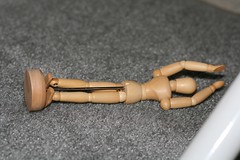Japan's been shaking like crazy this week. Among the decisions that have helped make Japan, as tremulous as it can be, among the safer places to be in an earthquake is that people have been trained in quake safety.
A basic step, if you live in an area that could possibly have a big quake, is to keep a stash of supplies -- food, water, safety gear, extra sturdy clothing -- where you'll be able to get to it easily afterwards. I refer to the comprehensive quake-kit list at sfgate.com when I need a reminder of what to include.
My area is decidedly red. We live near a fault that's overdue for a big quake. I lived through the Loma Prieta (from 60 miles away -- it was scary where I was, and damaging, but not devastating) and spent a long time nervous about earthquakes, afraid. I still have some nervous responses, but mostly I'm better, and I'm working on being more prepared.
At our house, we have camping equipment stored in the garage, and we specifically keep it right near the garage door, near the floor, where we can grab it if we have to. Even if that building were to collapse, we could find the camping equipment. And we're pretty sure we can stay in our yard, there aren't any hazards and it's not likely to liquefy. We also have a pen for the dogs, just in case, and extra leashes.
We need to work on storing that in a more organized way.
We keep important papers hidden in a fire-proof safe that we can access easily after a quake. I'm not worried about things like jewelry -- I don't have much, and even for the emotionally important stuff, ultimately it's just stuff. We want to keep ourselves safe and hydrated, and we want to keep the dogs safe, hydrated, and as calm as possible. Everything else is extra.
There are some things I don't do nearly often enough, and I don't have ready. For instance, I don't have a flashlight in my bedroom where I can grab it easily, or sturdy shoes always right near the bed. Both of those are easy enough to fix. I'm pondering getting a cheapo kid's backpack at a thrift store and making a small, basic pack for next to my bed, and one for the car. (It's a station wagon, impossible truly to hide anything of any size in there. I don't want to be a break-in target.)
Is there anything else? I'm sure I'm forgetting things specific to me (e.g. make sure I have three or four days of medication in my quake kits), and there might be something specific to you that's not on any list, that you should remember. Extra glasses if you're used to contacts and can't see at all without help? Disposable diapers and wipes?) What would you want to have in a kit that's not on standard readiness lists?
Ore from the former Alma Mine
2 hours ago

